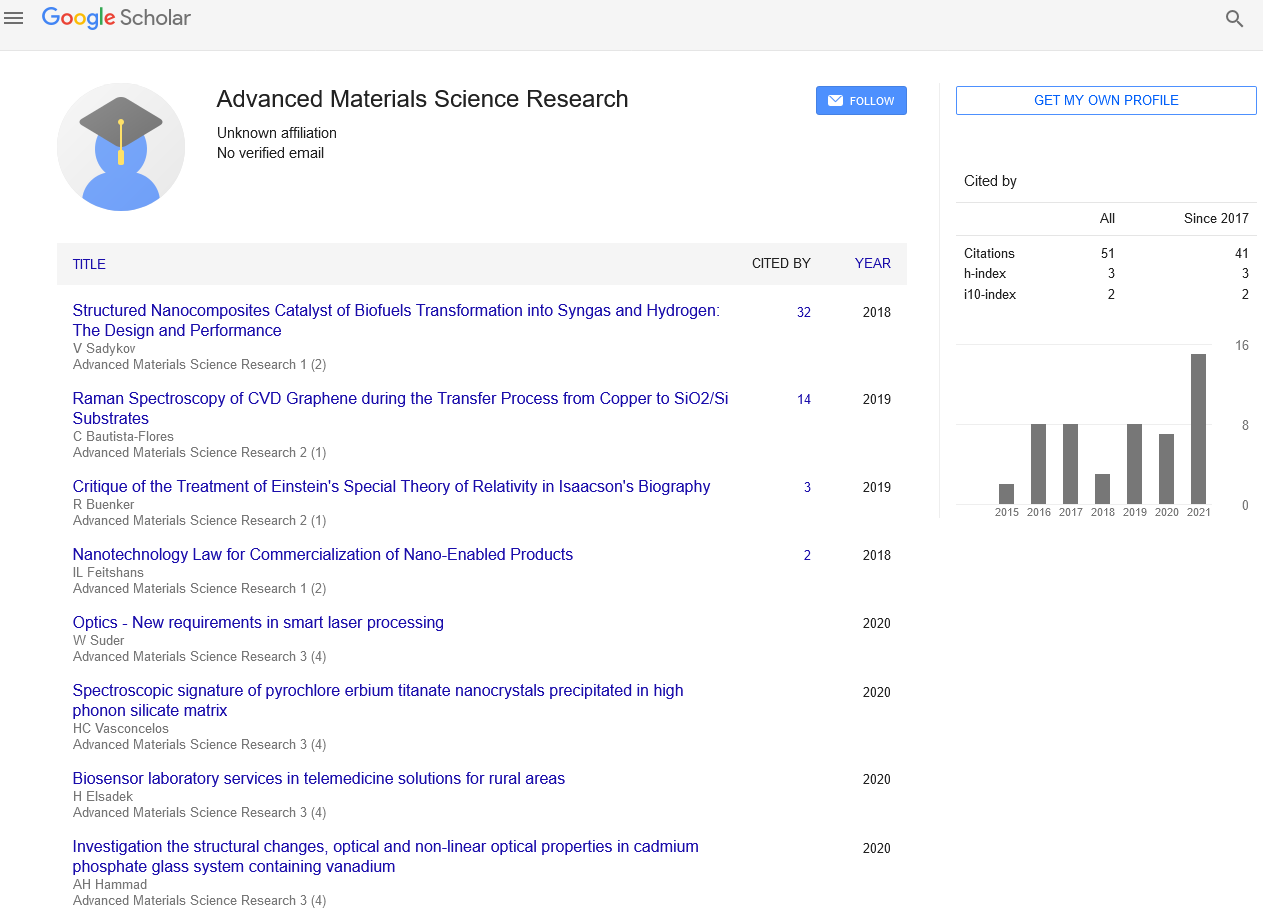Editorial - Advanced Materials Science Research (2023) Volume 6, Issue 4
Energy Materials: Advancing the World towards a Sustainable Future
John Khosla*
Department of Industrial Engineering and Management, University of Oulu, Finland
Department of Industrial Engineering and Management, University of Oulu, Finland
E-mail: Kjohn23@gmail.com
Received: 01-Aug-2023, Manuscript No. AAAMSR-23-108050; Editor assigned: 03-Aug-2023, Pre-QC No. AAAMSR-23-108050 (PQ); Reviewed: 17-Aug-2023, QC No. AAAMSR-23-108050; Revised: 22-Aug-2023, Manuscript No. AAAMSR-23-108050 (R); Published: 29-Aug-2023; DOI: 10.37532/ aaasmr.2023.6(4).52-54
Abstract
Energy materials are a diverse and critical class of substances that have emerged as fundamental components in advancing the world towards a sustainable future. This article's abstract highlights the significance and potential of energy materials in addressing the global challenges of climate change and depleting fossil fuel reserves. Energy materials encompass various substances, such as advanced batteries, solar cells, fuel cells, thermoelectric materials, and energy-efficient coatings. These materials are designed to efficiently store, convert, and transmit energy, enabling the seamless integration of renewable energy sources into our daily lives. Advanced batteries, exemplified by lithiumion technology, revolutionize energy storage and empower renewable energy systems with consistent power delivery. Solar cells, with on-going developments in perovskite and organic photovoltaic, harness solar energy to produce electricity efficiently. Fuel cells convert hydrogen and other fuels into clean electricity, offering potential for ecofriendly power generation. Thermoelectric materials, leveraging the See beck effect, enable electricity generation from waste heat, reducing energy losses. Energy-efficient coatings contribute to improved insulation and temperature regulation, thereby minimizing energy consumption in buildings and other applications. Researchers and industries are continually exploring innovative materials and technologies to enhance the efficiency, performance, and affordability of energy materials. The collaborative efforts of scientists, engineers, policymakers, and stakeholders are crucial in driving the widespread adoption of energy materials and accelerating the transition towards cleaner and more sustainable energy systems. Energy materials play a pivotal role in shaping a greener and more sustainable future. As advancements continue and barriers are overcome, the world stands to benefit from a cleaner energy landscape that mitigates climate change, reduces dependence on finite fossil fuels, and fosters a brighter, more sustainable tomorrow.
Keywords
Energy materials • Fuel cells • Lithium-ion technology • Policy makers
Introduction
As the world continues to grapple with the challenges posed by climate change and depleting fossil fuel reserves, the importance of sustainable and renewable energy sources becomes increasingly evident. Energy materials, a diverse group of substances that can efficiently store, convert, and transmit energy, play a vital role in driving the transition towards a cleaner and more sustainable energy landscape [1]. This article explores the significance and potential of energy materials in advancing the world towards a more sustainable future.
Energy materials and their role
Energy materials are a class of materials specifically engineered to optimize energy-related processes. They encompass a wide range of substances, including advanced batteries, super capacitors, solar cells, fuel cells, thermoelectric materials, and energy-efficient coatings [2]. The key to their success lies in their unique properties and ability to convert various forms of energy into usable power efficiently.
Advanced batteries
One of the most widely recognized energy materials is the advanced battery. These batteries have revolutionized energy storage, allowing renewable energy sources like solar and wind to deliver power consistently, even during periods of low generation. Lithium-ion batteries are a prime example, finding applications in electric vehicles, consumer electronics, and grid-scale energy storage systems [3].
Researchers are continually striving to develop batteries with higher energy densities, faster charging capabilities, and longer lifespans. Promising advancements in solid-state batteries and alternative chemistries like lithium-sulphur and lithium-air hold the potential to further enhance energy storage technologies [4].
Solar cells
Solar cells, also known as photovoltaic cells, are pivotal in harnessing solar energy to produce electricity. Silicon-based solar cells dominate the market, but emerging materials such as perovskite and organic photovoltaics show great promise due to their ease of fabrication and lower cost. Energy materials research focuses on enhancing the efficiency of solar cells, enabling them to capture more sunlight and convert it into electricity [5, 6]. Innovative approaches, like tandem solar cells that combine multiple materials to capture a broader range of the solar spectrum, are expected to boost solar energy adoption.
Fuel cells
Fuel cells are electrochemical devices that convert hydrogen and other fuels directly into electricity, emitting only water and heat as byproducts. These cells hold significant potential as a clean and efficient energy source for various applications, including transportation and stationary power generation. Researchers are working on improving fuel cell performance, durability, and reducing costs by using new catalyst materials, such as platinum-alternatives and nanostructured materials [7].
Thermoelectric materials
Thermoelectric materials possess the unique property of converting heat directly into electricity. This phenomenon, known as the See beck effect, can be harnessed to generate power from waste heat produced in industrial processes or vehicle engines. Advancements in nanotechnology and materials engineering have allowed researchers to improve the efficiency of thermoelectric materials, making them more suitable for widespread applications, such as in automotive waste heat recovery and wearable energy devices [8].
Energy-efficient coatings
Energy-efficient coatings encompass a variety of materials designed to minimize energy losses and improve energy efficiency. These coatings can be applied to buildings, windows, and other surfaces to enhance insulation, regulate temperature, and reduce the need for heating and cooling [9].
Examples of energy-efficient coatings include smart windows that dynamically adjust their transparency based on external conditions, thermo chromic materials that change color with temperature, and insulating coatings that prevent heat transfer [10].
Conclusion
Energy materials hold the key to a sustainable future by enabling the efficient capture, storage, and conversion of energy from renewable sources. As on-going research and technological advancements continue to improve the performance and affordability of these materials, we can expect a significant acceleration in the transition towards clean and renewable energy systems. With collaborative efforts from scientists, engineers, policymakers, and industries, energy materials will continue to play a pivotal role in shaping a greener and more sustainable world for generations to come.
References
- Chris S, Richard B, Richard B et al. Sustainable development in a post-Brundtland world.Ecol Econ. 57, 253-268(2006).
- BuRalli J, Junquei R. Moving towards the sustainable development goals: the unleash innovation lab experience.Ambient Soc. 21, e00010 (2018).
- Rosen M A. Sustainable development: A vital quest.Eur J Sustain Dev Res.1, 2542-4742(2017).
- Jovane F, Yoshikawa H, Alting L et al. The incoming global technological and industrial revolution towards competitive sustainable manufacturing.CIRP annals.57,641-659(2008).
- Winters LA, Yusuf S. Dancing with Giants: China, India and the Global Economy. 35–66(2007).
- Boe CR, Jovane F. Towards a New Model of Sustainable Production: ManuFuturing. Annals CIRP. 45,415–420(1996).
- Bakir A, Rowland SJ, Thompson RC. Transport of persistent organic pollutants by microplastics in estuarine conditions. Estuar Coast.Shelf Sci .140, 14–21(2014).
- Xiang Y, Jiang L, Zhou Y, et al. Microplastics and environmental pollutants: Key interaction and toxicology in aquatic and soil environments. J Hazard Mater. 422, 126843(2022).
- Hidayaturrahman H, Lee TG. A study on characteristics of microplastic in wastewater of South Korea: Identification, quantification, and fate of microplastics during treatment process. Mar Pollut Bull. 146, 696–702(2019).
- Ziheng L. Computational discovery of energy materials in the era of big data and machine learning: a critical review. Materials Reports Energy.1, 100047(2021).
Indexed at, Google Scholar, Crossref
Indexed at, Google Scholar, Crossref
Indexed at, Google Scholar, Crossref
Indexed at, Google Scholar, Crossref
Indexed at, Google Scholar, Crossref
Indexed at, Google Scholar, Crossref
Indexed at, Google Scholar, Crossref

